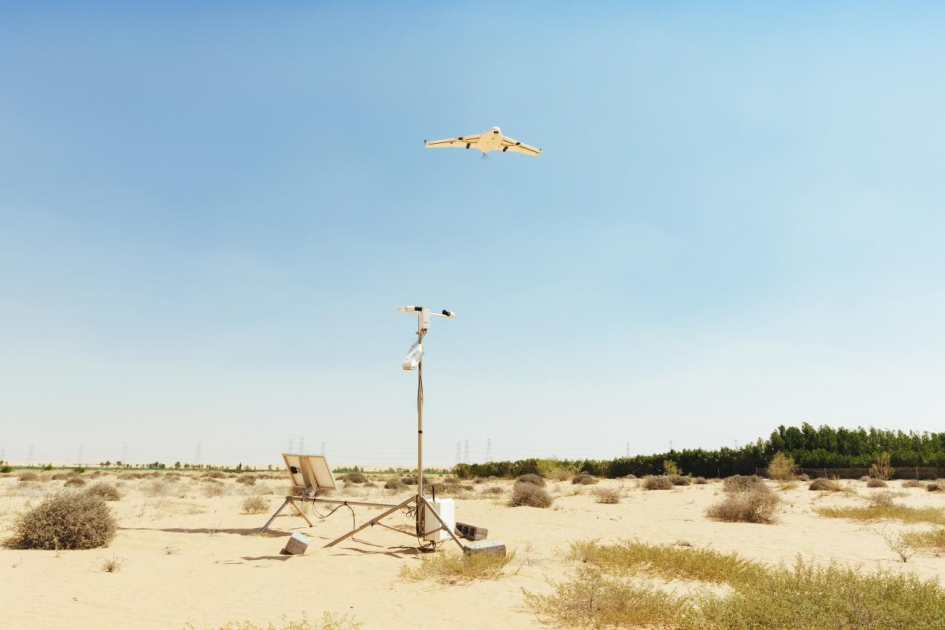
Releasing Charge from Robotic Aircraft Can Change Water Drops, Study Finds
Electric charge released into fog changes how water drops behave, a first-of-its-kind research from the University of Reading, supported by the National Centre for Meteorology in the UAE through its pioneering rain enhancement research program, has revealed.
Real world experiments have demonstrated that releasing charge led to detectable changes in the size and number of fog droplets. The new results are published in the journal Geophysical Research Letters.
The research follows earlier findings using a supercomputer to simulate how charge could influence raindrop formation, by encouraging growth of small water drops. This was reported in the Proceedings A of the Royal Society.
University of Reading meteorologists Giles Harrison, Maarten Ambaum and Keri Nicoll were awarded a $1.5 million research grant from the United Arab Emirates Research Program for Rain Enhancement Science (UAEREP) in 2017 to investigate the electrical aspects of rainfall.
.jpg)
His Excellency Dr. Abdulla Al Mandous, Director General of NCM and President of the Regional Association II (Asia) of the World Meteorological Organization (WMO): “We are delighted by the progress made by Professor Harrison and his team and we look forward to the continued application of the results of his research.”
He added: “At NCM, we continue to support the UAE’s efforts to extend the best possible support to the international scientific community through UAEREP, which undertakes ground-breaking research work in this increasingly important scientific domain. Our research response particularly focuses on developing innovative technologies and building new capabilities through promoting an experiment-based research approach that achieves clear scientific outcomes.”
Giles Harrison, Professor of Atmospheric Physics at the University of Reading, said: “We are pleased with our results from five years of investigations on droplets and charge, which span field measurements, computer simulations and new technology development.
“Our latest work has demonstrated how to use small aircraft to release sufficient charge to influence the behavior of water drops.”
“It has been rewarding to work with many international scientists on this ambitious and imaginative programme led by the National Center of Meteorology in the UAE.”
.jpg)
Some 2.3 billion people live in water-stressed countries according to the UN. Research into the properties of clouds and rainfall could therefore one day help avoid conflict over water, mitigate against using energy-intensive techniques to desalinate seawater, and provide enough water for a growing global population.
In March, 2021, the UAE Research Program for Rain Enhancement Science carried out a research campaign to evaluate the effectiveness of electric charge emission in modifying the behavior of cloud droplets in the UAE environment, and consequently enhancing the rainfall process. The campaign used UAVs flying at low altitudes to emit charge around a meteorological mast instrumented with an electric field mill to detect the charge at the surface.
Alya Al Mazroui, Director of the UAE Research Program for Rain Enhancement Science, said: “Our support for Professor Harrison's work has enabled us to pool our joint expertise and ensure that this innovative project will have the maximum impact in terms of new knowledge that could help to reduce water scarcity worldwide.”
“By serving as a hub for international scientific networks and enabling the creative interchange of ideas, the National Centre for Meteorology and the UAE Research Program for Rain Enhancement Science is promoting the most advanced research on cloud and rainfall science and technology and working hard to ensure new ideas and techniques can be more effectively utilized.”
.jpg)
How did the experiments work?
Professor Harrison and his team, which included mechanical and electrical engineers from the University of Bath, carried out two experiments in fogs.
The first experiment was at the University’s farm in Sonning, Berkshire, in 2020, where charge was released into fog using a fixed array of electric emitters.
The team found that there were more tiny water droplets when the charge was released, reported in the journal Physical Review Research.
In 2021, the team travelled to a farm in Somerset to operate their specially-developed battery-powered Uncrewed Aerial Vehicle (UAV), described in the American Meteorological Society’s Journal of Atmospheric and Oceanic Technology.
The UAV flew in circles above low level fog and released positive and negative charge separately and together.
When either the positive or negative charge was emitted, more water droplets were again formed. In contrast, no effect was observed when both positive and negative charge were emitted together.
This was the first time a UAV has been deployed to electrify fog with the goal of changing its constituent water droplets.
Why is this research important?
Other results of the research programme indicate that rainfall could be encouraged by charging specific sizes of water droplets, from the wide size range naturally present in clouds.
This could help dry regions, such as in the Middle East and North Africa, where water is needed most. Fieldwork undertaken by the project team has studied desert rainfall and effects of sea breezes in the Gulf, and sent specially instrumented weather balloons through the fogs of Abu Dhabi. This has been published in the journals Atmosphere and Environmental Research Letters.
Managed by the UAE National Center of Meteorology, UAEREP was created to address water security challenges worldwide.
According to UNICEF, some 700 million people could be displaced by intense water scarcity by 2030.
Inadequate sanitation is a problem for 2.4 million people, say World Wildlife Fund, exposing them to water-born diseases such as cholera and typhoid.
As the drones used to release the charge are battery-operated, no pollution is created from propelling the aircraft. The charge released dissipates naturally.
This means Professor Harrison and his team have developed a more environmentally-friendly method of weather modification, which could in principle operate automatically from multiple sites.


























